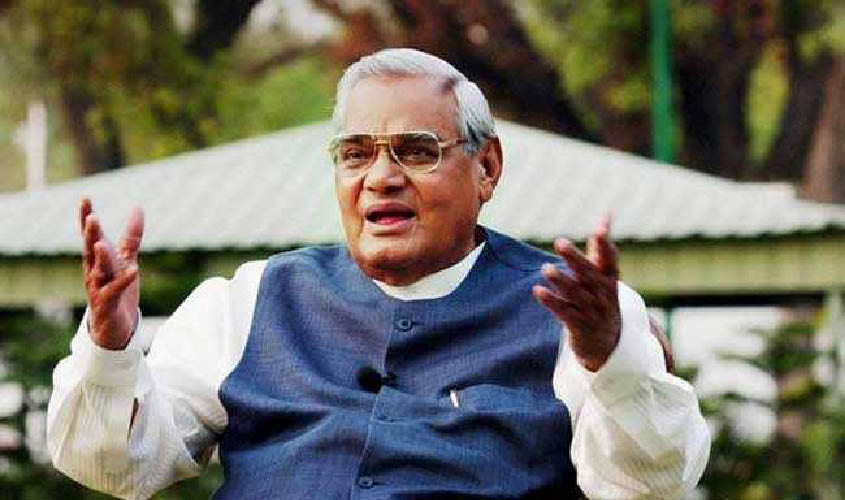Remembering Vajpayee
It’s never easy to sum up a legend, more so when it’s someone like Atal Bihari Vajpayee who has really been a towering figure in our political landscape. Everyone has a Vajpayee moment, and a Vajpayee anecdote which just showed how relevant he was even today when he has been out of active politics for over a decade. However, if you ask me about his legacy, then I would say it’s the way he embraced the concept of Parivar. For him, everyone was Family—from the party, to the Cabinet to those who worked in the PMO and also those who came calling. The lines between political and personal were blurred, for him everything was personal. If you came calling, regardless of whether you were a member of his Cabinet or an old party worker, you were given the choicest of mithais (a foodie, Vajpayee knew which sweet shop was famous for which mithai), and more importantly a patient meeting. The only ones who didn’t get such a patient hearing ironically enough were members of the Sangh Parivar, for Vajpayee went ahead with his economic agenda despite the objections from the swadeshi lobby.
Vajpayee and the media
Considering the current equation between the government and the media, it would be well to remember Vajpayee’s attitude, for he used to often look at a critical headline and say, “Today’s newspaper and tomorrow’s bhel-puri will be sold on it with it serving as a wrapper.” As simple as that. Though he always made it a point to stop and chat to us if he saw us in Parliament hanging outside his office, despite objections from his SPG. And all the hours waiting outside Race Course Road (as it was known then) for a meeting to get over, well, all we had to go was to call his house—and cups of tea and snacks would be served to all the waiting media.
The PMO
His Prime Minister’s Office has been the friendliest and most accessible that I have seen ever since I started covering politics—which would make it from Narasimha Rao onwards. He was Boss to Shakti Sinha, V. Anandrajan, Ajay Bisaria and Vikram Doraisamy, who have served as his private secretaries, but am sure he was also the best Boss they’ve had. Vajpayee used to groan every time Shakti walked in with an armful of files, but his PS had an informal rule of thumb—all files to be cleared within bahattar ghante (72 hours).
I remember visiting No. 7 Race Course Road (which served as the PM’s Office) during the afternoons when the PM used to take his nap and having a cup of coffee at the most powerful address in town. And once I even remember visiting Ajay and Anand when they had to decide the menu of an official dinner to be hosted for the Cabinet. So we got to sample every dish that was to be served! Since Ajay was from the IFS he was—understandably—not too familiar with the Cabinet faces. And so underneath the glass top on his desk was a photo-chart of every Cabinet minister which would help him identify some of the VIPs that came calling! The Sangh leaders who visited were all presented a shawl by the PM. And on one occasion when a rather senior Sangh pracharak asked for a bag to carry his shawl in, the only bag Ajay and Anand could come up with was a Nike one with “Just Do It” written boldly across it!
Not too far away, in South Block sat Brajesh Mishra, the PM’s best friend turned Principal Secretary and National Security Advisor. My favourite was Ashok Saikia, the no nonsense joint secretary who had little patience for petty politics, but was there simply because, like Brajesh Mishra, he had the PM’s trust. They were also the two people who were secure enough of their equation to tell him what they thought without fear of offending him. I recall asking Saikia once what his greatest achievement was, and he responded by telling me a story about an American soldier who returned from Vietnam and was asked what he got all his medals for. His response—the medals are not important, what’s important is that I survived.
And the claws within his own party were out for some of Vajpayee’s team, particularly Saikia and Mishra, for they were seen not as Parivar men, but an extention of Vajpayee’s Dining Table—as a journalist close to L.K. Advani put it once. But that’s the reason they were there for Vajpayee needed those whom he could trust. Another key member of Team Vajpayee was Ashok Tandon, his affable media advisor who kept a stern eye on the headlines of the day. Being a former journalist himself, Tandon knew exactly what we were looking for every time we came to him for a story, and how to brief us. Then there was N.K. Singh, him with his Hermes ties and Kishori Amonkar recordings, bringing branded equity to the no nonsense look of his colleagues. In fact, he took a few weeks to move into his office at South Block, waiting for his paintings and CD player to be installed before he moved in.
The Residence
It was Vajpayee’s foster daughter Namita Bhattacharya who lit his funeral pyre and there is no one else who is the true inheritor of the Vajpayee legacy. It is this family—Namita, Ranjan and Niharika—who were his core support group, and who were the family that moved in with him at 3 Race Course Road and later on to his Krishna Menon Marg residence. In fact, apart from Ranjan, the other two have rarely been in the limelight, avoiding all official functions. The first time one caught a glimpse of them in national media glare was, ironically enough, at Vajpayee’s funeral. That itself says it all.

